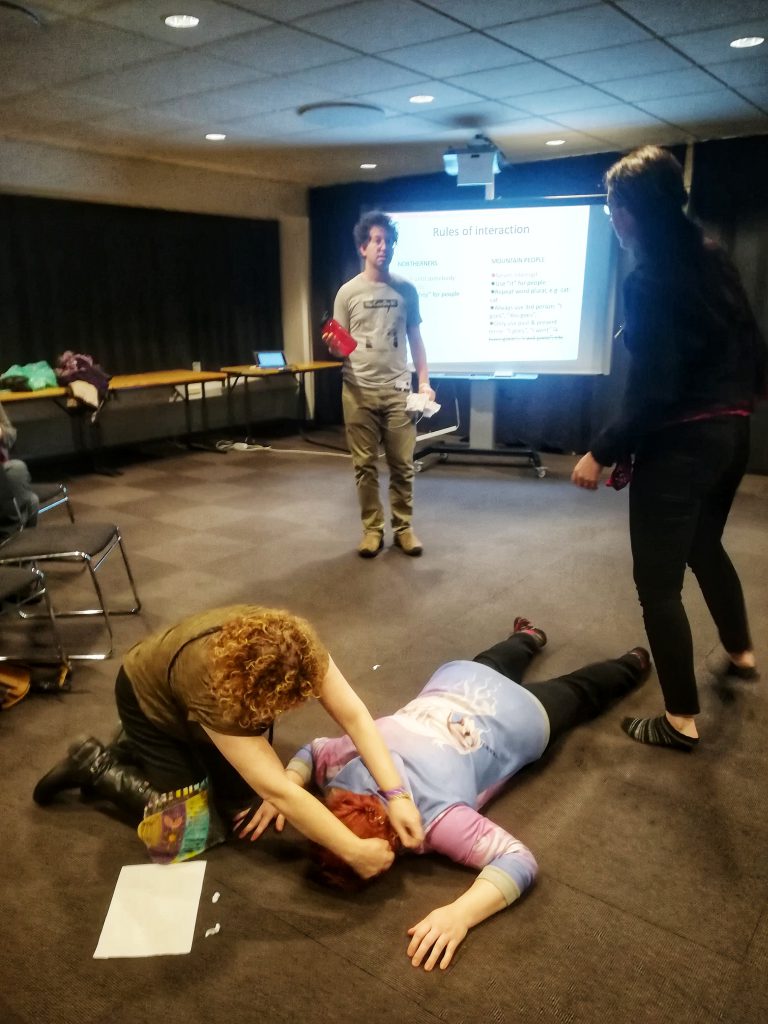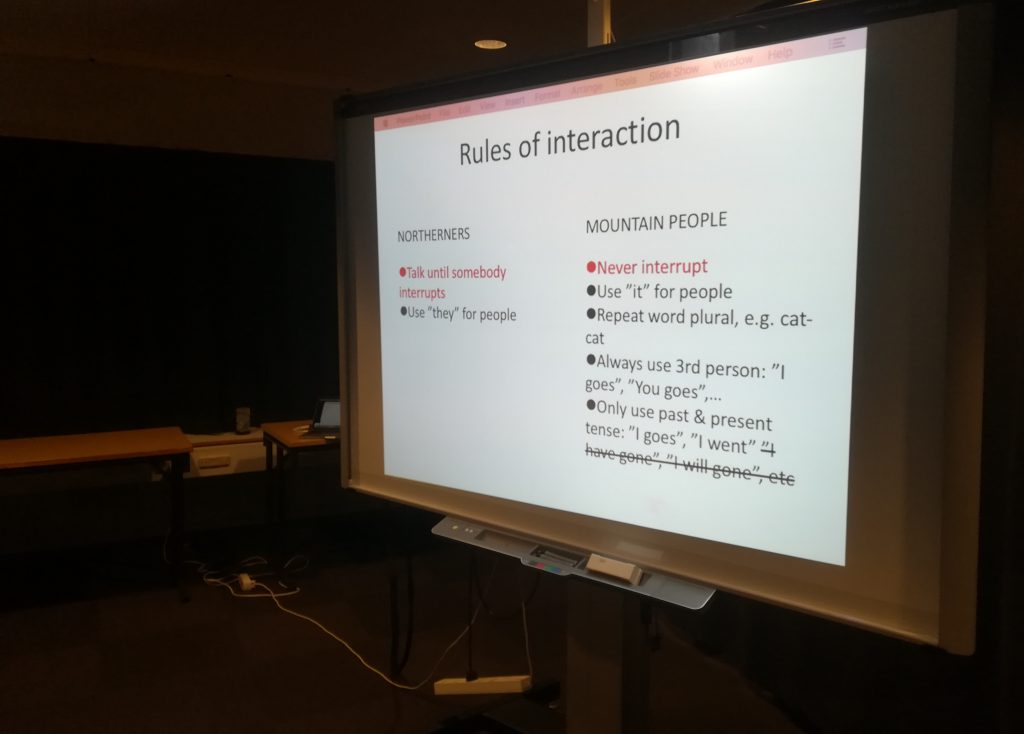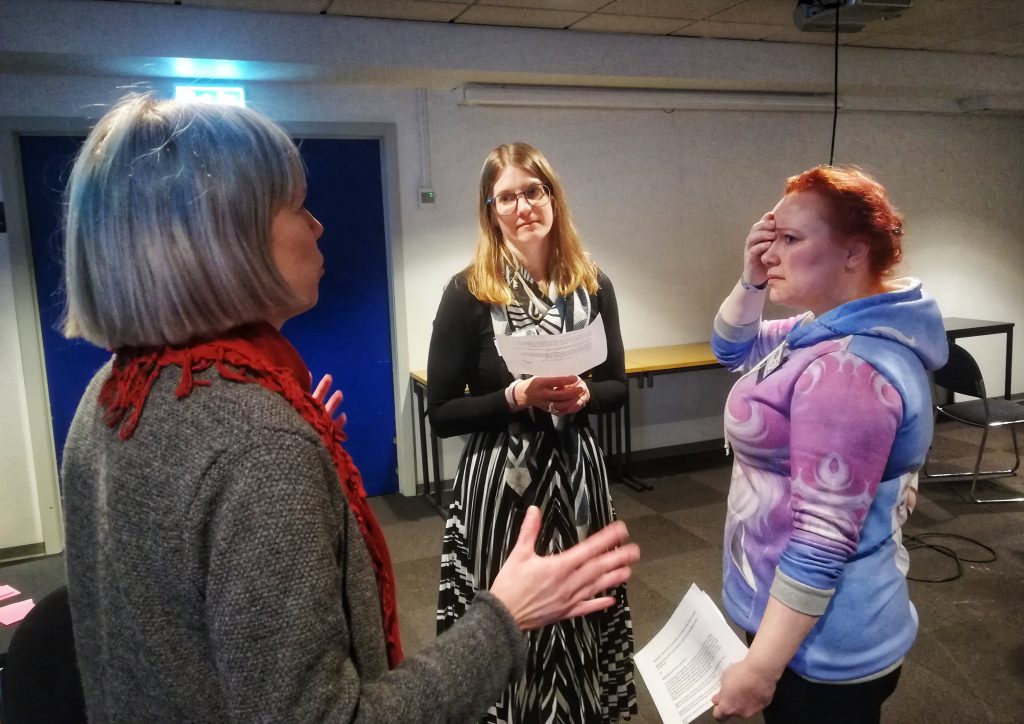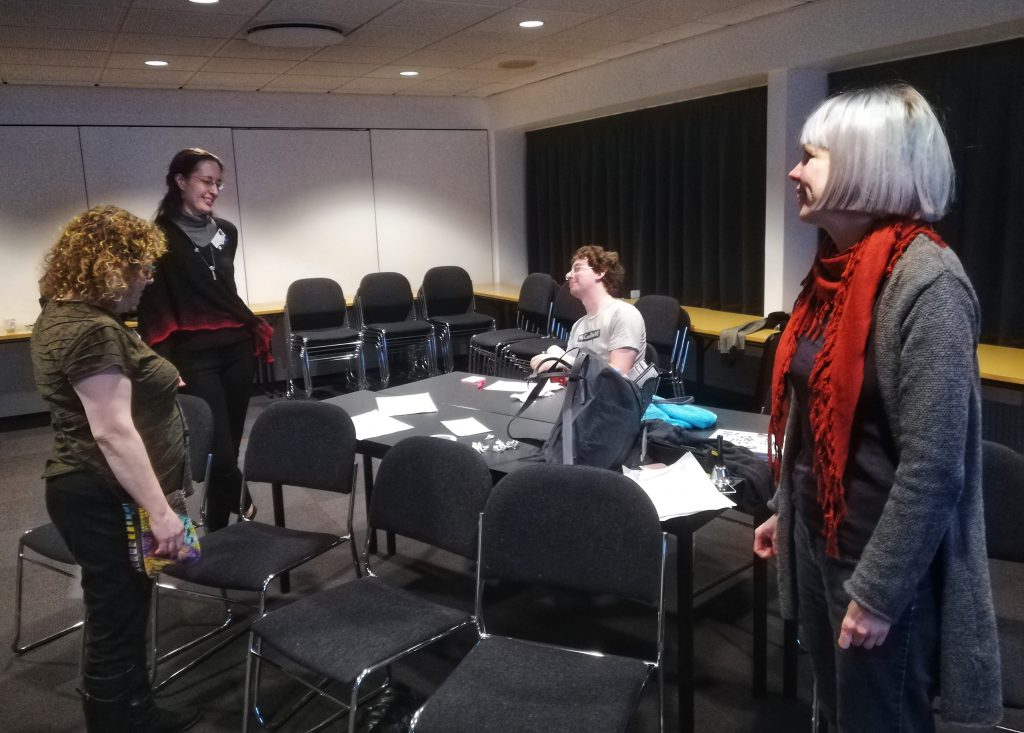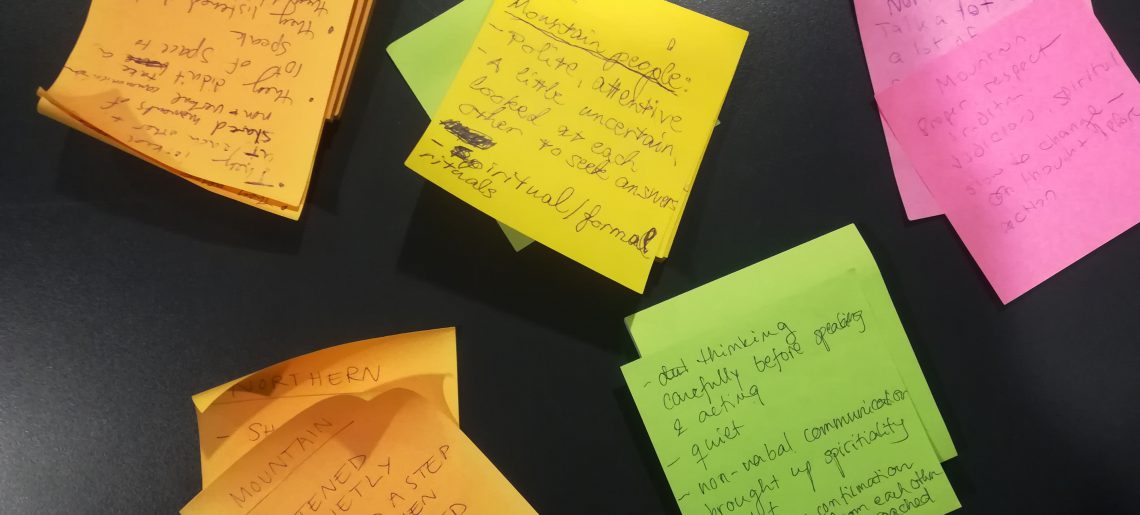
Duration: 4-5 hours
Players: 8 (4 Nordic and 4 English speaking North Americans)
Designer: Kaisa Kangas (2019)
Larpscript
PowerPoint
Photos: Katri Lassila (KP 2019 run)
Crash Course is a larp/freeform scenario that explores cultural differences between Nordic people and English-speaking North Americans through an allegory. There are two fictional cultures – the Northerners (played by Nordic players) and Mountain People (American players). The cultures of the Northerners and the Mountain people have similarities with the North American and Nordic cultures, respectively, but they are not meant to be one-to-one representations. Some of their features are just designed to create drama and conflict.
Northerners tend to talk a lot, especially about their feelings. Mountain People think silence is golden and tend to repress their emotions. Mountain People discuss things until they reach consensus, whereas Northerners have strict leadership hierarchies. Moreover, Northerners have a justice system based on “eye for an eye, tooth for a tooth”, and they use death and torture as punishments. In contrast, Mountain People don’t have a set way of treating people who break rules. Instead, they discuss each individual case with the whole community. As far as they remember, they have so far been able to settle everything by talking.
The main storyline of the larp is built around a misunderstanding about sex. Northerners have relaxed and casual attitudes towards sex, but Mountain People see it as the beginning of a lifelong commitment. In the larp, two young people – one from each culture – end up having sex and read completely different meanings into it. This evolves into a conflict between the two communities, and eventually a Mountain Person tries to kill a Northerner. The two groups then have to figure out together how to handle the situation although their interpretations of the events and views of justice diverge.
Design Motivations
I chose sex as the main source of conflict since human cultures tend to build many layers of meaning on sexuality. Moreover, sexuality and ideas connected to it are part of the core experience of being human, and it makes them relatable to most people. Although my main design method for this larp was role reversal, I decided not to use it when choosing the attitudes towards sex.
Instead, I made Nordic players play the casual culture and American players play the more reserved culture. I didn’t want the fictional cultures seem like carbon copies of my ideas of the real cultures. I also wanted to leave room for cultural bleed. For that, the in-game value systems needed to have some familiar aspect that the players could use as their interface to the fictional culture.
In the real world, people usually view sex through gendered lenses. For example, women are more often shamed for casual sex than men. I didn’t want to have these attitudes in the larp. Moreover, I wanted players to concentrate on cultural differences and a conflict between the cultures, not on gender. I didn’t want to complicate things by making the players think about possible gender roles in the setting. Thus, I decided that neither of the in-game cultures would have a notion of gender.
I decided both of the character groups would have an older generation and a younger generation (two characters each). At first, I thought about building parent/child relations between the age groups. Then I realized it would probably lead the players into thinking about gender since parenting is so strongly conceptualized with the gendered notions of mother and father. Instead, I designed relationships between a master and an apprentice, and told the players they could treat them a little bit like parent/child relations.
Mechanics
Game mechanics that restrict interaction have a big role in the larp. In fact, I came up with the mechanics long before I had an idea of the story. I believe the same mechanics could be used also in other fictional settings to explore cultural differences between Nords and English-speaking North Americans.
One of the rules of the larp is that Mountain People are not allowed to interrupt others and Northerners have to talk until somebody interrupts them. Moreover, there are restrictions on how Mountain People use English language. I wanted to create cognitive workload for native speakers and make them constantly think about language when they are speaking. I believed this would give them a feeling of how it is to communicate in a foreign language. At the same time, it would level out the differences between native and non-native speakers. My main inspiration was the larp KoiKoi (Norway, 2014) that also used language restrictions. I decided the Mountain People would use repeat word plural (“many cat-cat” instead of “many cats”), that they would always use third person singular for verbs (“I goes”, “You goes”, “We goes”, etc) and that they were only allowed to use two tenses, present (“goes”) and past (“went”).
The Mountain People were not supposed to openly express emotion, so they needed a way to read subtle cues to understand each other’s feelings. I decided to give each of them a sheet of paper that they could e.g. crush, fold, or tear to express emotion. Mountain People would be able to read this non-verbal communication. Northerners would not be able to read it in-game, but their players could use it as meta information.
Runs
When writing this, I have run the game twice. I first did a test run in Helsinki with an all-Finnish set of players. Then, I ran the game for Nordic and American players at Knudepunkt 2019 in Vejen, Denmark. The main difference with the two runs was that in the all-Finnish run, Northerners and Mountain People mixed more, and all the players tended to interact more as one big group. In the KP run, the two groups kept more to themselves and discussed more with each other before talking to the other group. Finns (I had them play the game in English) seemed to find the language restrictions more difficult than the native English speakers.
I had been afraid that the interruption mechanics might make the larp unsatisfactory to play for the Mountain People who would find it difficult to get to talk. In fact, the players did say that it was difficult, but in a way that created interesting play. Both groups said they really liked the paper mechanic.
If you decide to run the larp, I would like to hear from you. Please email me at kaisa.kangas@helsinki.fi
Acknowledgements:
I am grateful to my test players – Karoliina Artjoki, Halti I, Simo Järvelä, Maija Korhonen, Petra L, Vili N, Taina Nyman, and Dare Talvitie – for their feedback and valuable suggestions.
